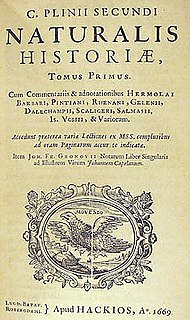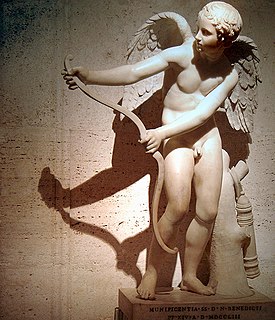Related Research Articles

Gaius Plinius Secundus, called Pliny the Elder, was a Roman author, a naturalist and natural philosopher, a naval and army commander of the early Roman Empire, and a friend of emperor Vespasian. He wrote the encyclopedic Naturalis Historia, which became an editorial model for encyclopedias. He spent most of his spare time studying, writing, and investigating natural and geographic phenomena in the field.

The Natural History is a work by Pliny the Elder. It is one of the largest single works to have survived from the Roman Empire to the modern day and purports to cover all ancient knowledge. The work's subject area is thus not limited to what is today understood by natural history; Pliny himself defines his scope as "the natural world, or life". It is encyclopedic in scope, but its structure is not like that of a modern encyclopedia. It is the only work by Pliny to have survived, and the last that he published. He published the first 10 books in AD 77, but had not made a final revision of the remainder at the time of his death during the AD 79 eruption of Vesuvius. The rest was published posthumously by Pliny's nephew, Pliny the Younger.

Myron of Eleutherae, working c. 480–440 BC, was an Athenian sculptor from the mid-5th century BC. He was born in Eleutherae on the borders of Boeotia and Attica. According to Pliny's Natural History, Ageladas of Argos was his teacher.

In Greek mythology, the Naiads are a type of female spirit, or nymph, presiding over fountains, wells, springs, streams, brooks and other bodies of fresh water.

Polykleitos was an ancient Greek sculptor in bronze of the 5th century BC. Alongside the Athenian sculptors Pheidias, Myron and Praxiteles, he is considered one of the most important sculptors of classical antiquity. The 4th century BC catalogue attributed to Xenocrates, which was Pliny's guide in matters of art, ranked him between Pheidias and Myron. He is particularly known for his lost treatise, the "Canon of Polykleitos", setting out his aesthetic theories of the mathematical bases of artistic perfection.

Apelles of Kos was a renowned painter of ancient Greece. Pliny the Elder, to whom much of modern scholars' knowledge of this artist is owed, rated him superior to preceding and subsequent artists. He dated Apelles to the 112th Olympiad, possibly because he had produced a portrait of Alexander the Great.

Lysippos was a Greek sculptor of the 4th century BC. Together with Scopas and Praxiteles, he is considered one of the three greatest sculptors of the Classical Greek era, bringing transition into the Hellenistic period. Problems confront the study of Lysippos because of the difficulty of identifying his style among the copies which survive. Not only did he have a large workshop and many disciples in his immediate circle, but there is understood to have been a market for replicas of his work, supplied from outside his circle, both in his lifetime and later in the Hellenistic and Roman periods. The Victorious Youth or Getty bronze, which resurfaced around 1972, has been associated with him.

Euphranor of Corinth was a Greek artist who excelled both as a sculptor and as a painter.
Kresilas was a Greek sculptor in the Classical period, from Kydonia. He was trained in Argos and then worked in Athens at the time of the Peloponnesian war, as a follower of the idealistic portraiture of Myron. He is best known for his statue Pericles with the Corinthian helmet.
Epigonus of Pergamum was the chief among the court sculptors to the Attalid dynasty at Pergamum in the late third century BCE.

The Sleeping Hermaphroditus is an ancient marble sculpture depicting Hermaphroditus life size. In 1620, Italian artist Gian Lorenzo Bernini sculpted the mattress upon which the statue now lies. The form is partly derived from ancient portrayals of Venus and other female nudes, and partly from contemporaneous feminised Hellenistic portrayals of Dionysus/Bacchus. It represents a subject that was much repeated in Hellenistic times and in ancient Rome, to judge from the number of versions that have survived. Discovered at Santa Maria della Vittoria, Rome, the Sleeping Hermaphroditus was immediately claimed by Cardinal Scipione Borghese and became part of the Borghese Collection. The "Borghese Hermaphroditus" was later sold to the occupying French and was moved to The Louvre, where it is on display.
Polycles, mentioned in Pliny's Natural History (XXXV.8.19), was an ancient Greek sculptor who flourished during the 102nd Olympiad. He was a contemporary of Cephisodotus the Elder and Leochares. Among the statues of Olympian winners, Pausanias (Description of Greece noted the statue of a winner in the pankration by the Athenian Polycles, probably this one.
Polycles, an ancient Greek name, may refer to:

The Venus Genetrix is a sculptural type which shows the Roman goddess Venus in her aspect of Genetrix, as she was honoured by the Julio-Claudian dynasty of Rome which claimed her as their ancestor. Contemporary references identify the sculptor as a Greek named Arcesilaus. The statue was set up in Julius Caesar's new forum, probably as the cult statue in the cella of his temple of Venus Genetrix. Through this historical chance, a Roman designation is applied to an iconological type of Aphrodite that originated among the Greeks.

The Athena of Velletri or Velletri Pallas is a type of classical marble statue of Athena, wearing a helmet.
Pythagoras of Samos or Pythagoras of Rhegion, was a sculptor from Samos whom Pliny the Elder expressly distinguishes from the more renowned Pythagoras from Rhegion. Pliny does however say that the sculptor bore a remarkable personal likeness to the mathematician. There is no precise indication of his date. Philip Smith accepted the opinion of Karl Julius Sillig (1801—1855) that Pliny's date of Olympiad 87 ought to be referred to this artist rather than to a different Pythagoras, from Rhegium; other writers consider it possible he lived closer to the beginning of the 5th century BC. Modern writers consider it certain these two were the same artist, and that this Pythagoras was one of the Samian exiles who moved to Zankle at the beginning of the 5th century BC and came under the power of the tyrant Anaxilas in Rhegium. While a Samian by birth, he was a pupil of Clearchus of Rhegium.

The Epistulae are later copies of a series of personal missives by Pliny the Younger directed to his friends and associates. These letters are a unique testimony of Roman administrative history and everyday life in the 1st century. The style is very different from that in the Panegyricus, and some commentators maintain that Pliny initiated a new genre: the letter written for publication. This genre offers a different type of record than the more usual history; one that dispenses with objectivity but is no less valuable for it. Especially noteworthy among the letters are two in which he describes the eruption of Mount Vesuvius in 79 during which his uncle Pliny the Elder died, and one in which he asks the Emperor for instructions regarding official policy concerning Christians.

Phellus is a town of ancient Lycia, now situated on the mountainous outskirts of the small town of Kaş in the Antalya Province of Turkey. The city was first referenced as early as 7 BC by Greek geographer and philosopher Strabo in Book XII of his Geographica, alongside the port town of Antiphellus; which served as the settlement's main trade front.
Apollodorus was a sculptor of ancient Greece, who made statues in bronze. He was so fastidious that he often broke his works in pieces after they were finished, and hence he obtained the surname of " the madman," in which character he was represented by the sculptor Silanion. Assuming from this that the two artists were contemporary, Apollodorus flourished about 324 BCE.
References
- ↑ Pliny the Elder, Natural History, xxxiv.(19).52
- ↑ Pliny the Elder, Natural History, xxxvi.(4).35.
| This Ancient Greek biographical article is a stub. You can help Wikipedia by expanding it. |